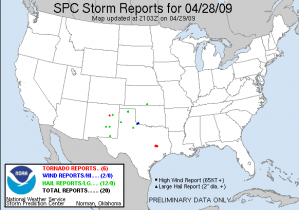 |
Posted on May 6th, 2009 by Susan Yowell | Filed under Business Continuity Planning, Drills, Pandemics/Epidemics, Preparedness, Service Continuity Planning
| No Comments »
Yesterday, Tuesday, May 5, we convened a meeting at our library to review our pandemic plans and conduct a brief table-top exercise. The meeting produced some excellent observations and insights, both for successes and things we need to work out. The first half of the meeting was a review of our procedures, based the table (see below in the “Planning for Service Continuity During a Pandemic” post) from our library’s emergency preparedness plan. All the “key players” attended, including: the library’s emergency response coordinator, the library Director, IT manager, web development manager, business manager, head of reference services, collection development manager, database coordinator, ILL supervisor, and Circulation supervisor. All these positions played roles in the planning and in the response exercise. The scenario we used for the table-top exercise: it is 3 PM on a Sunday afternoon, when the University decides to close all the libraries on campus to enact social-distancing measures. The closure is intended to prevent the spread of influenza resulting from a pandemic. What is done immediately? What is done Monday morning? Before beginning the discussion of procedures for this scenario, participants drew slips of paper from a bowl, which designated them as “sick” or “well.” One-third of the participants were designated “sick,” and therefore did not play a role in the exercise. This pointed out the need for back-up in certain key positions.
Some questions arose that might be helpful to others in the planning process, among them:
- can you change the voice mail message on your library’s main phone from your home? who has the authority and the access needed to do this? who is the backup for that person?
- who has current staff home phone number information? is someone responsible for keeping the list upddated, and for distributing it? should lists be given to everyone, or to select people?
- do the appropriate library staff have access to the “Ask a Librarian” chat function from home?
- do you need an official “voice” for providing information about the status of the library? if so, will that person have access to communication channels, such as announcements on your web site?
- can the person responsible for ILL/Document Delivery access resources needed to provide ILL requests to your patrons from home, i.e. is the required software installed on the home computer/laptop?
- is there a provision for emergency access to print materials for affiliated patrons in the event of a patient-care emergency while the library is closed?
- is there an institutional need for designating a way to account for time worked at home by library staff?
Besides refining our procedures and identifying a few areas to be improved, everyone agreed that the meeting/exercise was an excellent way to keep emergency preparedness, and pandemic planning particularly, in our corporate awareness.
Posted on May 4th, 2009 by Susan Yowell | Filed under Earthquakes, Featured Web Site, Preparedness, Toolkit Tips
| No Comments »
The U.S. Geological Survey has made available a wealth of information about earthquakes, among them the “Today in Earthquake History” page . A look at the page for May 4 shows several significant earthquakes around the world, two of which were in Alaska in 1923 and 1934. By looking at the “Earthquake Reports” section in the left menu bar here on the Toolkit, you will note that Alaska is experiencing tremors again today. The USGS has also provided an excellent Preparedness and Response page, all important information, particularly for everyone who lives on the west coast of North America, Alaska and Hawaii.
Posted on April 30th, 2009 by Dan Wilson | Filed under Business Continuity Planning, Pandemics/Epidemics, Service Continuity Planning
| No Comments »
This would be a good time to review your pandemic planning procedures and perform a table-top drill. For instance, are you ready to continue access to your resources and core services if your library is closed for, say, one week? Click on the link below to view a table from the University of Virginia’s Health Sciences Library’s Emergency Preparedness & Response Plan detailing the assignment of responsibilities in the event of a pandemic. Feel free to borrow.
Pandemic Planning Responsibilities
Also, if you would like more information on the interlibrary loan backup plan developed by the University of Virginia Health Sciences Library and the Health Sciences Library at the University of North Carolina/Chapel Hill, please see the article in the April 2009 issue of the Journal of the Medical Library Association.
Posted on April 30th, 2009 by Dan Wilson | Filed under Disaster Incidents & Hazardous Weather Outlook, Hazardous Weather, Severe Storm, Tornadoes
| No Comments »
At last week’s Hospital Librarians Summit, it was suggested that we link to a site that would show reports of weather-related events. As a result, we now have a link to NOAA’s Storm Prediction Center’s report of the previous day’s storms. The link (Yesterday’s Storm Reports) is located on the right column of the Toolkit under the category Alerts and Reports.

Posted on April 28th, 2009 by Susan Yowell | Filed under Current Incidents and Alerts, Featured Web Site, Health Alerts
| No Comments »
The Disaster Information Research Center (DIMRC) of the National Library of Medicine’s Specialized Information Services division has produced a comprehensive web resource for health professionals including the Federal Response, International Resources, Genetic Sequence Information, PubMed Searches, Veterinary Resources and Información en Español: “Enviro-Health Links–Swine Flu”
Posted on April 28th, 2009 by Susan Yowell | Filed under Current Incidents and Alerts, Featured Web Site, Health Alerts
| No Comments »
The Agency for Healthcare Research and Quality, a department of the U.S. Department of Health and Human Services, has produced “Tools and Resources for Influenza Preparedness” in response to the current evolving situation regarding swine flu. There is much information here for public health facilities, hospitals and other emergency management planners, based on the ongoing research of AHRQ. Check it out!
Posted on April 27th, 2009 by Susan Yowell | Filed under Featured Web Site, Health Alerts, MedlinePlus
| No Comments »
In the interest of providing current information about swine flu for consumers, NLM is providing the page “Swine Flu“, which summarizes information from CDC and other sources.
Posted on April 26th, 2009 by Susan Yowell | Filed under Business Continuity Planning, CDC, Communication, Core Resources, Health Alerts, Pandemics/Epidemics, Service Continuity Planning
| No Comments »
The CDC is updating this site http://www.cdc.gov/swineflu/ frequently at this point, in order to help everyone stay current with the swine flu situation. See the “CDC Health Advisory” on this page for the most current information. I heard on NPR today that Mexico has closed churches, schools, concert halls, and other public spaces to try and slow the spread of the disease. Should these social-distancing measures be enacted for public spaces, including libraries in the U.S., be aware of measures that libraries can take to keep resources and core services available to their patrons even if their buildings are closed. Have an alternate home page ready, to show altered hours, to highlight online resources, and to offer online chat services to patrons who need help. Also remember to change the voice mail message on your library’s main telephone to reflect changed hours and availability of online resources and services.
Here is more information from the U.S. Department of Health and Human Services, available on their Pandemic Flu web site: http://www.pandemicflu.gov/ The Swine Flu Info widget from HHS is available there to be copied into web pages–this will provide quick access to “Information,” “Investigation,” and “What you can do” sources.
Posted on April 15th, 2009 by Susan Yowell | Filed under Disaster Incidents & Hazardous Weather Outlook, Featured Web Site, Flooding, Suggested Readings
| No Comments »
It’s good to be “on the same page” with an organization like Heritage Preservation! Check out their “Do One Thing” initiative for May Day (May 1) this year. They encourage all libraries and cultural institutions to take some of the same actions the NN/LM is recommending to its members in its “10-Step Approach to Service Continuity,” such as prioritizing collections for rescue, establishing relationships with “buddy” institutions, etc. They also mention that their Disaster Wheel and accompanying Field Guide are on sale at a special price for May Day. These materials have been highly recommended to NN/LM members throughout the training sessions in emergency preparedness and response that have been offered over the past year and a half.
The Heritage site also notes that even though hurricane “season” doesn’t start until June 1, our continent is already experiencing severe weather and flooding, noting that a disaster can happen at any time and in any place. If you visit their site, you might enjoy looking around a bit while you are there. Heritage Preservation (a partner with FEMA) is an excellent resource for all things preservation and recovery for collections. Where the NN/LM emergency preparedness initiative complements Heritage is its focus on service continuity to patrons in terms of providing health related information.

Posted on April 3rd, 2009 by Susan Yowell | Filed under Meeting Reports, Training
| No Comments »
On Monday of this week, we met with NN/LM staff at the South Central Region’s office at the Houston Academy of Medicine at the Texas Medical Center. Michelle Malizia, Associate Director, and her capable staff made the meeting a big success. Also attending were SCR’s state coordinators for emergency preparedness (see photo below).
Following an outstanding breakfast, the group introduced themselves and then heard an update from Dan about the progress of the NN/LM Emergency Preparedness & Response Project since last year when we visited Houston. The remainder of the morning session contained the “train the trainer” session for the group about teaching the “10 Step Approach to Service Continuity Planning.” The afternoon session consisted of a lively discussion of other issues to be addressed during this year, with many helpful comments and suggestions from SCR staff as well as the state coordinators.
We enjoyed seeing the SCR staff as well as all the state coordinators and hearing about activities in their region. They maintain their close-knit network of information and support within the region, which is reinforced by the relative frequency of emergencies in the region due to hurricanes.
 SCR Train the Trainer session
|
 |








